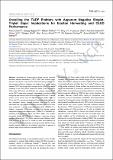Files in this item
Unveiling the TADF emitters with apparent negative singlet-triplet gaps : implications for exciton harvesting and OLED performance
Item metadata
| dc.contributor.author | Chen, Xinrui | |
| dc.contributor.author | Bagnich, Sergey | |
| dc.contributor.author | Pollice, Robert | |
| dc.contributor.author | Li, Bing | |
| dc.contributor.author | Zhu, Yuanyuan | |
| dc.contributor.author | Saxena, Rishabh | |
| dc.contributor.author | Yin, Yixiao | |
| dc.contributor.author | Zhu, Weiguo | |
| dc.contributor.author | Aspuru-Guzik, Alan | |
| dc.contributor.author | Zysman-Colman, Eli | |
| dc.contributor.author | Köhler, Anna | |
| dc.contributor.author | Wang, Yafei | |
| dc.date.accessioned | 2023-11-13T11:30:09Z | |
| dc.date.available | 2023-11-13T11:30:09Z | |
| dc.date.issued | 2023-09-28 | |
| dc.identifier | 294201781 | |
| dc.identifier | f56e453d-da77-4699-9999-d5b335a1841d | |
| dc.identifier | 85172913482 | |
| dc.identifier.citation | Chen , X , Bagnich , S , Pollice , R , Li , B , Zhu , Y , Saxena , R , Yin , Y , Zhu , W , Aspuru-Guzik , A , Zysman-Colman , E , Köhler , A & Wang , Y 2023 , ' Unveiling the TADF emitters with apparent negative singlet-triplet gaps : implications for exciton harvesting and OLED performance ' , Advanced Optical Materials , vol. Early View , 2301784 . https://doi.org/10.1002/adom.202301784 | en |
| dc.identifier.issn | 2195-1071 | |
| dc.identifier.other | RIS: urn:C9638A377526BC13801BF67B437A01BF | |
| dc.identifier.other | ORCID: /0000-0001-7183-6022/work/143918298 | |
| dc.identifier.uri | https://hdl.handle.net/10023/28680 | |
| dc.description | Financial support was from the National Natural Science Foundation of China (Nos. 22371020, 52073035) and the Special program for foreign talents in Changzhou City (CQ20224052). R.P. acknowledges funding through a Postdoc. Mobility fellowship by the Swiss National Science Foundation (SNSF, Project No. 191127). A.A.-G. thanks Dr. Anders G. Frøseth for his generous support. A.A.-G. also acknowledges the generous support of Natural Resources Canada and the Canada 150 Research Chairs program. A.K., S.B., and R.S. acknowledge funding from the Deutsche Forschungsgemeinschaft (KO 3973/8-1) and through the EU HORIZON-MSCA-2021-DN TADF solutions, project number 101073045. E.Z.-C. acknowledges support from the Engineering and Physical Sciences Research Council (EP/W015137/1 and EP/X026175/1). | en |
| dc.description.abstract | Intramolecular through-space charge transfer thermally activated delayed fluorescence (TSCT-TADF) has attracted much attention recently as it can achieve both small energy splitting and high emission efficiency. However, the relationship of excited states between TSCT and through-bond charge transfer (TBCT) remains a challenge in the TSCT-TADF molecules. Herein, three compounds DPS-m-bAc, DPS-p-bAc, and DPS-OAc that possess emissive TSCT and/or TBCT states are prepared. Interestingly, a so-called inverted energy gap is found for both DPS-m-bAc and DPS-p-bAc in toluene solution, which results from the different charge transfer states of ICThigh and ICTlow, as proved by the detailed transient photoluminescence and calculated results. Intense emission from blue to yellow associated with high photoluminescence quantum yields of 70–100% are measured in doped polymethyl(methacrylate) (PMMA) films. Notably, compound DPS-m-bAc achieves the highest reverse intersystem crossing rate constant (kRISC) of over 107 s−1 in a PMMA film, benefiting from close-lying TSCT and TBCT states. The solution-processed device with DPS-m-bAc displays a maximum external quantum efficiency of 21.7% and a relatively small efficiency roll-off (EQE of 20.2% @ 100 cd m−2). Overall, this work demonstrates how with judicious emitter engineering, a synergy between different charge transfer excited states, can be achieved, providing an avenue to achieve highly efficient solution-processed OLEDs. | |
| dc.format.extent | 3198330 | |
| dc.language.iso | eng | |
| dc.relation.ispartof | Advanced Optical Materials | en |
| dc.subject | Charge transfer | en |
| dc.subject | Delayed fluorescence | en |
| dc.subject | Fast reverse intersystem crossing | en |
| dc.subject | Solution-processed OLED | en |
| dc.subject | Thermally activated delayed fluorescence | en |
| dc.subject | QD Chemistry | en |
| dc.subject | DAS | en |
| dc.subject.lcc | QD | en |
| dc.title | Unveiling the TADF emitters with apparent negative singlet-triplet gaps : implications for exciton harvesting and OLED performance | en |
| dc.type | Journal article | en |
| dc.contributor.sponsor | EPSRC | en |
| dc.contributor.sponsor | UKRI (EU) | en |
| dc.contributor.institution | University of St Andrews. Centre for Energy Ethics | en |
| dc.contributor.institution | University of St Andrews. EaSTCHEM | en |
| dc.contributor.institution | University of St Andrews. School of Chemistry | en |
| dc.identifier.doi | 10.1002/adom.202301784 | |
| dc.description.status | Peer reviewed | en |
| dc.identifier.grantnumber | EP/W015137/1 | en |
| dc.identifier.grantnumber | EP/X026175/1 | en |
This item appears in the following Collection(s)
Items in the St Andrews Research Repository are protected by copyright, with all rights reserved, unless otherwise indicated.

